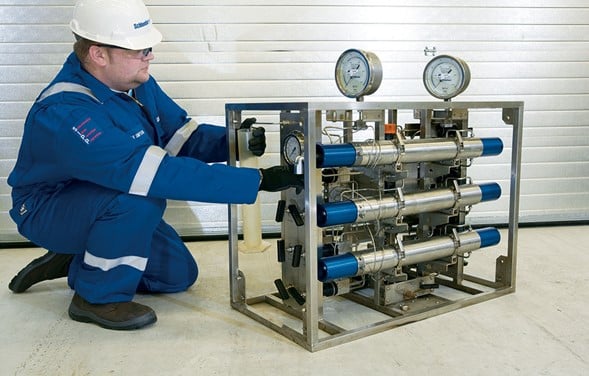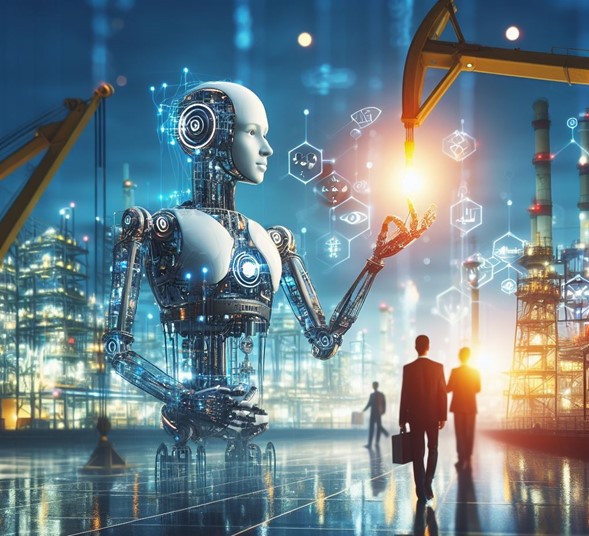The oil industry is one of the most important in the world, and its development is closely linked to technological innovation. In recent years, automation and robotics have seen rapid growth in the sector, with a significant impact on the construction of oil facilities.
This article explores the significant and growing impact of these technologies on one of the world’s most vital and challenging sectors. From the implementation of distributed control systems to the adoption of autonomous robots for inspection and maintenance tasks.
Impact of industrial automation and robotics
Throughout history, the oil industry has been associated with considerable investments in infrastructure and technology. From manual drilling to advanced automation, this industry has undergone a remarkable evolution. However, it is in the last decade where it has undergone a significant change.
Automation and robotics are contributing to a profound transformation in the way oil facilities are built. These technological advances are improving the efficiency, safety and sustainability of operations, and opening new opportunities for innovation.
Current state of technology
With the advent of advanced technologies, the construction of oil facilities has improved in efficiency and safety. Automated systems and remotely controlled robots are performing tasks that were previously dangerous for personnel, such as:
- Tank and pipeline inspection robots: These are designed to perform detailed inspections on oil storage tanks and pipelines. They can detect leaks, corrosion and other structural problems without the need for personnel to enter potentially dangerous areas. Example: The Autonomous Tank Inspection Robot, by Square Robot .
- Aerial drones for monitoring and mapping: Drones equipped with advanced cameras and sensors are used to monitor large oil facilities, providing real-time images and data. These drones can map hard-to-reach areas and perform security monitoring. Example: The Matrice 300 RTK, which is used for aerial inspections and infrastructure mapping.
- Robots for underwater operations: Used in offshore operations, known as remotely operated vehicles (ROV), they perform inspection, maintenance and repair tasks in underwater facilities. They are essential for the deepwater oil industry . Example: Eelume’s “eROV” ROV, which can maneuver with agility in complex underwater environments.
- Robots for preventive maintenance: These robots perform preventive maintenance tasks, such as lubricating machinery, cleaning surfaces, and checking operating conditions. Example: Robots like “ANYmal” from ANYbotics, designed for inspection and maintenance in complex industrial environments.
- Autonomous systems for leak detection: Equipped with advanced sensors, these can detect gas or oil leaks in real time, allowing rapid intervention to avoid environmental disasters. Example: LIDAR sensors and systems used in autonomous vehicles for rapid and accurate leak detection.
- Distributed Control Systems (DCS): They are the heart of automation in oil and gas processing plants. They control and monitor refining processes, ensuring they operate efficiently and safely, an example is Emerson’s “DeltaV” DCS system, which provides highly integrated and optimized process control.
- Well monitoring and control systems: Used to optimize oil extraction, these systems automate the control of well production, including regulating pressure, temperature and flow. An example would be Schlumberger’s “Wellhead” well control system, which allows precise remote monitoring and control, as can be seen in Figure 1.

- Real-Time Information Management Systems (RTIMS): These systems collect data from multiple sources in an oil operation and present it in real time to assist in decision making. For example, the “Honeywell Forge” system offers data analysis and visualization solutions to optimize operations.
- Automated materials handling systems : In refineries, these systems are used for the automated transportation and handling of materials, reducing errors and improving efficiency. For example, automated conveyor belt systems for handling raw materials and refined products.
These Robots and autonomous systems not only increase productivity and efficiency, but also significantly improve safety in a high-risk industrial environment. The integration of automation and robotics in the oil industry is an important step towards more sustainable and responsible operations.
Contributions and solutions to the oil and related sector
The implementation of automated systems and robotics in the energy sector has provided significant and valuable solutions. These technological advances are contributing to a profound transformation in the way this sector operates. Some of the most important contributions and solutions are:
- Improvement in operational efficiency: They significantly increase the efficiency of energy operations, due to more efficient management of resources, a reduction in downtime and an optimization of energy production and distribution processes.
- Increased safety at work: These technologies reduce the need for technical personnel intervention in dangerous tasks, such as exploration in extreme environments or the handling of hazardous materials; which reduces the risk of accidents and improves the general safety of workers.
- Reduction of environmental impact: They can optimize the use of resources and energy, which contributes to a smaller environmental footprint. For example, with automation in energy management, greater efficiency in consumption and a reduction in greenhouse gas emissions can be achieved.
- Predictive and preventive maintenance: Robotics and intelligent monitoring systems allow predictive and preventive maintenance of equipment and facilities to be carried out, preventing failures and extending the useful life of the equipment, reducing long-term costs.
- Improved data-driven decision making: Automation and robotics generate large amounts of operational data that, properly analyzed, can offer valuable insights for making appropriate strategic decisions.
- Innovation in exploration and production: In the oil and gas sector, robotics has enabled exploration and production in previously inaccessible environments, such as deep waters or arctic regions, thus expanding the possibilities of resource extraction.
- Integration of renewable energies: Automated systems facilitate the integration of renewable energy sources by allowing more efficient and adaptive management of the variability in the production of these sources, such as solar or wind.
- Training and development of new skills: The adoption of these technologies is also driving training and development in the workforce, which is vital for the modernization and sustainability of the sector.
These contributions are paving the way towards a more sustainable, secure and efficient energy future, which is crucial to meeting the challenges of climate change and growing global energy demand.
Innovations
Recent innovations in AI and robotics
- Machine learning and adaptability: Modern robots, equipped with AI, not only perform pre-programmed tasks, but can also learn from their environment and experiences. For example, robots equipped with machine learning algorithms can improve their ability to identify and repair defects in underwater pipes and structures, which is crucial in the offshore industry.
- Improved decision-making: The integration of AI in robotics allows more informed and accurate decisions to be made. For example, in the oil industry , robots can evaluate data in real time to optimize inspection routes, identify critical areas for maintenance, and predict potential failures.
- Advanced human interaction: Advances in AI enable better robot-human interaction. This is especially useful in environments where collaboration between robots and workers is necessary for efficiency and safety, such as on oil platforms.
Future trends in industrial automation and robotics
Future trends in automation and robotics anticipate a revolution in the way manufacturing and production companies carry out their operations (figure 2). The integration of artificial intelligence, machine learning and more advanced robotic technologies is shaping a landscape where automation not only improves efficiency, but also opens up new possibilities in terms of customization, agility and adaptability in industrial environments. From flexible manufacturing to close collaboration between humans and robots, these trends are paving the way to a smarter, more efficient industrial future.

- Comprehensive operations management: Robotics and AI are expected to be used not only for operational tasks, but also for the comprehensive management of oil operations. This includes strategic planning, resource management and emergency response, all based on real-time data analysis.
- Strategic decision automation: Advances in AI and Big Data analysis will allow oil companies to make strategic decisions based on a deep, real-time understanding of the market, geopolitical trends and consumption patterns.
- Advanced autonomous robotics: In the future, we expect to see fully autonomous robots capable of performing complex tasks without human intervention, from exploration to repair and maintenance, even in extreme conditions.
- Integration of renewable energy: An emerging area is the integration of these technologies in renewable energy management, where AI can optimize energy production and distribution, balancing renewable sources with market demands.
- Sustainability and environmental responsibility: AI and robotics will continue to play an important role in improving sustainability and minimizing the environmental impact of oil operations, by optimizing processes and reducing emissions and waste.
The integration of AI into robotic systems represents a monumental advance in the oil industry , taking operations, safety and efficiency to new levels. These technologies are not only transforming current operations, they are shaping the future of the industry, promising a smarter, safer and more sustainable approach to energy resource management.
Success stories and key personalities
- Success stories: A notable example is the Shell company, which has implemented autonomous robots to inspect its facilities, improving the safety and efficiency of its operations.
- Sector Personalities: Innovators such as Elon Musk, with their commitment to automation technology in different industries, have also indirectly influenced the oil sector, driving greater investment in advanced technologies.
Conclusion
New technologies are marking a before and after in the construction and operation of oil facilities; they are not only improving efficiency and safety, but are also contributing to the sustainability and profitability of the industry. As we move towards a more technological future, it is crucial that companies continue to invest and innovate in these areas to remain competitive and sustainable in the global market.
Be Part of the Technological Innovation in the Oil Industry!
References
- Infobae.com: The robot revolution: how automation will transform employment.
- Petroleumag: The oil and gas industry is embracing robotics
- Faster Capital: Redefining the future leveraging disruptive technology for business innovation

